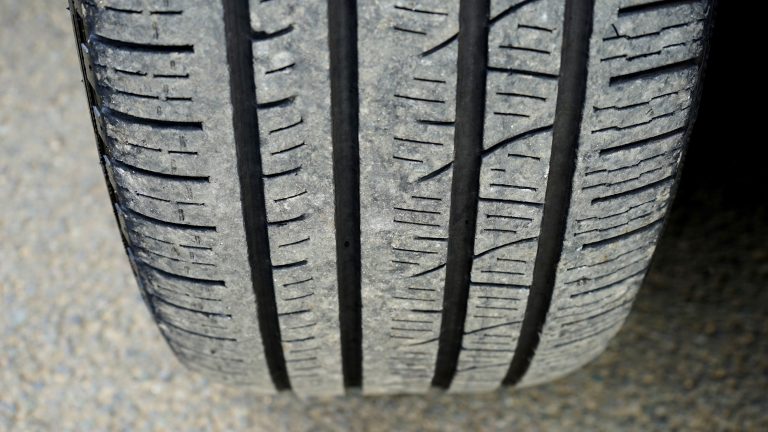Imagine driving down the highway on a road trip, listening to your favorite playlist when suddenly you feel a jolt and hear a loud thumping noise. You pull over to discover a flat tire. It’s a frustrating and potentially dangerous situation that could have been avoided with proper tire maintenance.
Regular tire checks and maintenance not only keep you safe on the road but also extend the lifespan of your tires, saving you money in the long run. In this article, we’ll cover everything you need to know about tire maintenance, from how to check your tire pressure to know when it’s time for a replacement.
Key Takeaways
- Proper tire maintenance is important for a variety of reasons, including your safety while driving.
- Tire storage is essential for preserving the appearance and performance of your tires, especially if you switch between sets of tires.
- Check your tires for proper inflation, tread depth, and signs of wear or damage once a month.
Table of Contents
The Importance Of Tire Maintenance
Tire maintenance is essential for several reasons. For starters, it guarantees your safety while driving. Overinflated or underinflated tires can also cause uneven tread wear and blown tires, which can cause accidents and damage to the vehicle.
Second, proper tire maintenance leads to increased fuel efficiency, which means more miles per gallon (mpg) and less money spent on gas. Maintaining proper tire pressure can boost fuel efficiency by 3%. Driving on underinflated tires wastes approximately 1.2 billion gallons of fuel in the United States alone each year.
Finally, properly maintaining your tires helps them last longer, which is good for the environment. According to the California Air Resources Board, properly inflated tires could reduce greenhouse gas emissions. As a result, regular tire maintenance is crucial to ensure your safety, save money on gas, and reduce your carbon footprint.
Tire Pressure
When the tire pressure in your vehicle is low, it can create a stressful situation for you as a driver while you’re on the road. Air molecules become less active in cold weather, resulting in a decrease in air pressure inside and outside your tires. When the temperature drops by 10°F, the tires’ air pressure can drop by 1-2 pounds per square inch (psi).
Underinflated tires can make your car feel unresponsive and sluggish. To ensure precise handling and complete control while driving in the winter, check your tire pressure every time you fill up your gas tank.
How To Check Tire Pressure
Maintaining proper tire air pressure is important for your vehicle’s safety and performance. As a result, you should check it at least once a month or before a long trip. Look inside the driver’s side door frame or consult your owner’s manual to determine the recommended PSI for your tires. If you’re still unsure, you can always seek advice from a tire dealer.
When checking the pressure, make sure the tires are cool before proceeding. Then, take an accurate measurement with a tire gauge. If you need to add or release air, remember to replace the valve cap after you’re finished. While you’re at it, give your tires a once-over to make sure there are no leaks, embedded objects, or unusual wear patterns. If you notice anything out of the ordinary, you should have a car care professional look it over.
Tire Tread
Tread depth is necessary for tires to grip the road and handle wet conditions. Check your tire tread once a month to ensure it is wearing evenly and not becoming too thin. Tread depth can be measured with a gauge purchased at a parts store or with the “quarter and penny” tests.

How To Check Tire Tread Depth
Flip a penny upside down and insert it into the grooves on your tire to see if your tread is too low. When you can see the top of Lincoln’s head, it’s time for new tires.
Another way to check your tire tread is to look for these little strips of smooth rubber built into the tire called “wear bars.” If the tread has worn down to the level of the wear bars, which is approximately 2/32 of an inch, it is time to replace the tires as well. So keep an eye out for those wear bars and drive safely.
Signs Of Wear Tire
Here are some signs that your tires may be worn and need to be replaced:
- Uneven wear on your tires could indicate a misalignment problem or improper inflation. This type of wear can reduce tire life and have an impact on vehicle handling.
- Tires can develop cracks in the sidewall or tread as they age. These cracks can form as a result of heat or sunlight exposure and can lead to a dangerous blowout.
- Bulges or blisters on the tire sidewall can be caused by hitting a pothole or a curb. These problems can weaken the tire’s structure, resulting in a blowout.
- Excessive vibration while driving could be a sign of tire wear or a problem with the wheel alignment.
- Tires with a low tread depth can reduce traction and increase stopping distance, especially in wet weather.
If you notice any of these tire wear signs, you should take your vehicle to a reputable tire service center to have them checked and possibly replaced.
Tire Rotation
It is critical to follow the tire rotation schedule recommended in your owner’s manual. Tire rotations should be performed every 5,000 to 7,000 miles or every other oil change. It’s also crucial to have a professional inspect each tire during rotation to detect any signs of uneven wear and correct any underlying issues before they cause further damage. This will not only help your tires last longer, but it will also help them perform better on the road.
How To Rotate Tires Properly
A mechanic’s wheel alignment is recommended every 5,000 to 7,000 miles to avoid uneven tire wear and unsafe steering. During a tire rotation, a mechanic will remove each tire from the vehicle and replace it in a different position. If you notice your car has a problem, like pulling to one side or the other, it may be time for an alignment. Regular tire maintenance is not only a quick and simple process, but it also ensures your safety and may save you money in the long run.
Tire Balancing
Tire balance aims to distribute weight evenly around the entire circumference of the tire. Unbalanced wheels can cause annoying vibrations while driving, resulting in premature wear on suspension and steering components, rotating parts, and tires.
Tire balancing should be part of your routine vehicle maintenance. It is recommended that you have your tires balanced every 5,000-10,000km or at least once every 1-2 years (whichever comes first).
How To Identify Signs Of Unbalanced Tires
Look for visible wear and damage, such as a smooth and worn-out tread pattern on one tire or tire cupping, where parts of the tire appear to be missing, to identify signs of unbalanced tires. Another sign of unbalanced tires is when your vehicle begins to shake or vibrate, which can be felt in your steering wheel or front seat if one of your front tires is out of balance, or in the back of your car and your back seats if one of your rear tires is out of balance.
Unbalanced tires can also make your steering wheel less responsive and your vehicle less fuel-efficient due to increased road resistance, which forces your engine to work harder to maintain a constant speed and accelerate. Humming or buzzing noises from your tire, as well as worn shocks and bearings, may indicate unbalanced tires.
Wheel Alignment
Wheel alignment entails adjusting the suspension of a vehicle, which is the link between the car and its wheels. This is distinct from adjusting the wheels or tires themselves. When your car’s alignment is off, it may drift to one side of the road or shake while driving. It is critical to have regular wheel alignments performed throughout the year to ensure optimal performance and tire life. These services can improve your vehicle’s handling and tire durability.
How To Identify Signs Of Misalignment
Driving on dirt roads or in off-road conditions, hitting potholes or curbs, or being in a collision can all cause misalignment. Even minor misalignments can cause significant differences in tire wear, which can be costly in the long run. The three most obvious signs of misaligned wheels are:
- When driving straight, the steering wheel is off-center.
- While driving, the steering wheel vibrates.
- When the steering wheel is straight, the car leans slightly in one direction.
To avoid such problems, check your alignment every 10,000 km or as recommended by the car manufacturer in the owner’s manual.
Tire Storage
Proper tire storage is essential for preserving their appearance and performance, especially if you switch between sets of tires. Tires should be stored indoors in a clean, cool, and dry environment if they have been unused outdoors for an extended period, typically a month or more.
How To Store Tires When They Are Not In Use
When switching between sets of tires, proper storage is required to maintain the appearance and performance of your tires. Tires should be stored in a clean, cool, and dark indoor location away from direct sunlight, heat, and ozone sources such as hot pipes or electric generators. If you must store them outside for a short period, raise the tires off the ground and use a waterproof covering with holes to prevent moisture buildup.
Furthermore, the surfaces on which the tires are stored must be free of grease, gasoline, solvents, oils, and any other substances that could deteriorate the rubber. To avoid staining the black rubber on your tires with whitewall or raised white lettering, store them with the whitewall or raised white lettering facing each other.
Age Of Tires
Tires are not designed to last forever. They have a limited lifespan that is determined by factors like usage, maintenance, and storage conditions. Knowing the age of your tires is important because it can impact your driving safety. Regardless of the amount of tread remaining, the recommended lifespan of a tire is six years from the date of manufacture.
However, if your tires show signs of damage or wear before the six-year mark, you should replace them right away. Furthermore, if your tires are more than six years old, you should have them inspected by a professional tire technician and consider replacing them even if they appear to be in good condition.
Even if tires appear to be in good condition, they can become more prone to failure as they age. The rubber can crack and dry out, resulting in a blowout while driving. This is especially dangerous at high speeds or when the road is wet or slippery.
Tire Selection
The proper tire for your vehicle is crucial for both safety and performance. Here are some things to think about when choosing tires:
- The tire size is usually indicated on the sidewall of your current tires or in the owner’s manual of your vehicle. Make sure to select a tire that is the correct size for your car.
- Consider the weather and road conditions you will encounter while driving. If you live in a snowy or rainy area, you may want to consider winter or all-season tires for better traction and grip.
- Different types of vehicles necessitate different types of tires. Trucks and SUVs, for example, may require tires that can handle heavier loads, whereas sports cars may require tires that provide better performance and handling.
- The tread life of a tire refers to how long it is expected to last before it needs to be replaced. When selecting tires with an appropriate tread life, consider your driving habits and frequency of driving.
- Finally, take into account the tire’s brand and price. While it may be tempting to go with the cheapest option, investing in a quality tire from a reputable brand can improve long-term safety and performance.
How Often Should You Check Your Tires?
Check your tires at least once a month for proper inflation, tread depth, and signs of damage or wear. What’s more, you should inspect your tires before long trips and during temperature changes, such as the transition from summer to winter. Remember that regular tire maintenance can help ensure optimal tire performance, extend tire life, and improve overall road safety.
FAQs About Tire Maintenance
What happens if I drive on underinflated or overinflated tires?
Driving on underinflated tires can reduce fuel efficiency, cause uneven tire wear, and result in potentially dangerous handling. Overinflated tires can result in a harsh ride and reduced traction.
Can I repair a flat tire, or do I need to replace it?
A flat tire can usually be repaired if the puncture is on the tread and not the sidewall. If the tire is severely damaged or worn, it may need to be replaced.
How do I know if my tires need to be balanced or aligned?
Vibration or shaking while driving at certain speeds are indicators that your tires need to be balanced. Uneven tire wear, pulling to one side while driving, or a crooked steering wheel while driving straight are all signs of misalignment.
What should I do if I hit a pothole or other road hazard?
If you hit a pothole or other road hazard, inspect your tires for visible damage or sidewall bulges. If you notice any problems, have a professional check your tires.






